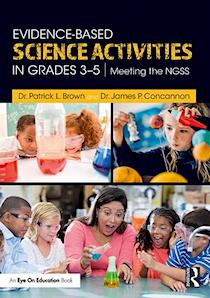Evidence-Based Science Activities (Grades 3-5)
Evidenced-Based Science Activities in Grades 3-5: Meeting the NGSS
By Dr. Patrick L. Brown and Dr. James Concannon
(Routledge/Eye On Education, 2019 – Learn more)
Dr. Brown and Dr. Concannon do an excellent job beginning to tell the story of how the Next Generation Science Standards can be addressed in grade 3-5 classrooms. There are parts of this text I like as well as some parts that I am struggling with a bit.
I like the term evidence-based learning because it’s important for students to construct their explanations based on evidence from their own questions and investigations, but I am put off by the title of the book, Evidenced-Based Science Activities in Grades 3-5: Meeting the NGSS, because the new standards are asking us to move away from “activity land” which tends to be very topic based learning that occurs when students are figuring out something vs learning about something,

I also noted that the Framework for K-12 Science Education was missing from the citations for this chapter. The majority of references cited for further reading are meaningful but are based on research prior to 2011. The exception to this was the 2012 article written by Kate McNeill and Joe Krajcik.
Chapter 2, although brief, is filled with important information about the how and why of science learning. The sequence of the instruction is critical. The chapter talks about “explore before explain” and “activity before content,” etc. There is also discussion about the 5E learning cycle. My thinking is that this chapter feels incomplete because it does not include phenomenon-driven instruction where student learning begins with excitement and curiosity derived from their own questions.
In Chapter 3 although the science learning is definitely steeped in inquiry, and student inquiry is at the heart of the NGSS, authors of the newer research have intentionally chosen not to use the term because of confusion in the field about what inquiry is or is not. Instead, when students are engaged in science and engineering practices, they are also engaged in the steps described in the book as inquiry.
Chapter 4, “Using Phenomenon-Based Teaching as a Pathway to Evidence-Driven Science Education,” is my favorite in the book. It digs into the pedagogy of science teaching that is expected and addressed in both the in A Framework for K-12 Science Education and the Next Generation Science Standards.
Interesting and intriguing phenomena will breed extensive student questions. From all of the student questions, a driving question is developed to begin our investigations. The driving question must be engaging and meaningful to all students, placing them in a position to investigate, collect data and construct explanations. The students “want to figure out the answer the driving questions.”
This type of science instruction makes students want to come back to your classroom every day because they cannot wait to dig in again and try to figure out exactly how that energy stick can explain transfer of energy, or how a Wooly Willy toy can help us better understand that a magnet doesn’t have to touch a material to affect it, or how to make bracelets using UV beads can help us better understand the effects of sunlight on our skin.
Chapter 5 is a brief introduction to the Next Generation Science Standards. The chapter intends to connect the way instruction has happened in the past to the way it should happen using the new standards. For me, when I think about the new science standards, the paradigm shift is more about how we teach than what we teach.
Chapter 6 invites readers into the classroom of one of the authors to see how he engages students in science and engineering practices in a manageable way. He shares how fourth and fifth graders are engaged in a three-to-four day investigation learning about forces and interactions. One component that I very much like is the idea that a written CER not only meets science standards but can also be used to address/assess literacy standards.
Chapters 7-10 provide the reader with model lessons that can give them a sense of where and how they might get started in changing science instruction in the classroom.
Chapter 11 is a reflection of the work the authors have done with teachers. The intent is to assist teachers of science to make the paradigm shift to the new standards. Changing practice is always difficult, but it can be managed.
This book is a very easy read and might be useful in changing the way science instruction happens in the classroom. There are some excellent points in the book, although I think some are still too muted. As mentioned above, the research is valuable and meaningful, but there is newer research available.
Kathy Renfrew (@krsciencelady) has been a Science Coordinator for the Vermont Agency of Education and a district-level Science Content Specialist. During her long career in education, Kathy has taught science in upper elementary and middle grades, often in rural schools with multi-level classrooms. She is an NBCT and an NGSS Curator and has been a field editor for NSTA’s Next Gen Navigator newsletter. She holds a M.Ed. in Science Education (K-8). Kathy blogs at MiddleWeb’s The Science Lady.



































Thank you for your thorough review. I truly appreciate your thoughts on the book! Best wishes, Jim Concannon